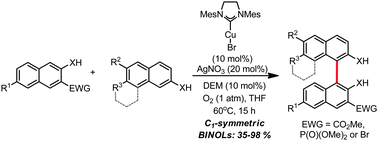Heterocoupling of 2-naphthols enabled by a copper–N-heterocyclic carbene complex†
Abstract
The reactivity of a Cu

* Corresponding authors
a
Département de Chimie, Centre for Green Chemistry and Catalysis, Université de Montréal, CP 6128 Station Downtown, Montréal, Québec, Canada H3C 3J7
E-mail:
shawn.collins@umontreal.ca
The reactivity of a Cu

 Please wait while we load your content...
Something went wrong. Try again?
Please wait while we load your content...
Something went wrong. Try again?
M. Holtz-Mulholland, M. de Léséleuc and S. K. Collins, Chem. Commun., 2013, 49, 1835 DOI: 10.1039/C3CC38675A
To request permission to reproduce material from this article, please go to the Copyright Clearance Center request page.
If you are an author contributing to an RSC publication, you do not need to request permission provided correct acknowledgement is given.
If you are the author of this article, you do not need to request permission to reproduce figures and diagrams provided correct acknowledgement is given. If you want to reproduce the whole article in a third-party publication (excluding your thesis/dissertation for which permission is not required) please go to the Copyright Clearance Center request page.
Read more about how to correctly acknowledge RSC content.
 Fetching data from CrossRef.
Fetching data from CrossRef.
This may take some time to load.
Loading related content
